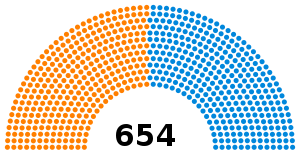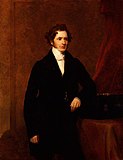1852 United Kingdom general election
| |||||||||||||||||||||||||||||||||||||
All 654 seats in the House of Commons 328 seats needed for a majority | |||||||||||||||||||||||||||||||||||||
|---|---|---|---|---|---|---|---|---|---|---|---|---|---|---|---|---|---|---|---|---|---|---|---|---|---|---|---|---|---|---|---|---|---|---|---|---|---|
| |||||||||||||||||||||||||||||||||||||
 Colours denote the winning party—as shown in § Results | |||||||||||||||||||||||||||||||||||||
 Composition of the House of Commons after the election | |||||||||||||||||||||||||||||||||||||
| |||||||||||||||||||||||||||||||||||||
The 1852 United Kingdom general election was held between 7 July 1852 and 31 July 1852 to elect members of the House of Commons, the lower house of Parliament of the United Kingdom. It was a watershed in the formation of the modern political parties of Britain. Following 1852, the Tory/Conservative party became, more completely, the party of the rural aristocracy, while the Whig/Liberal party became the party of the rising urban bourgeoisie in Britain. The results of the election were extremely close in terms of the numbers of seats won by the two main parties.
As in the previous election of 1847, Lord John Russell's Whigs won the popular vote, but the Conservative Party won a very slight majority of the seats. However, a split between Protectionist Tories, led by the Earl of Derby, and the Peelites who supported Lord Aberdeen made the formation of a majority government very difficult. Lord Derby's minority, protectionist government ruled from 23 February until 17 December 1852. Derby appointed Benjamin Disraeli as Chancellor of the Exchequer in this minority government. However, in December 1852, Derby's government collapsed because of issues arising out of the budget introduced by Disraeli. A Peelite–Whig-Radical coalition government was then formed under Lord Aberdeen. Although the immediate issue involved in this vote of "no confidence" which caused the downfall of the Derby minority government was the budget, the real underlying issue was the repeal of the Corn Laws which Parliament had passed in June 1846 and had split the Conservative Party. In this election, there were 18 Peelites elected in England and Wales. The constituency of St Albans (UK Parliament constituency), with its two members, was disfranchised due to corruption. This accounts for the fact that there were two fewer seats in the House of Commons as compared to the previous election, though no redistribution took place.
Corn Laws
[edit]A group within the Tory/Conservative Party called the "Peelites" voted with the Whigs to achieve the repeal of the Corn Laws. The Peelites were so named because they were followers of Prime Minister Robert Peel. In June 1846, when Peel was the Prime Minister of a Tory government, he led a group of Tory/Conservatives to vote with the minority Whigs against a majority of his own party.
"Corn" was important to the cost of living of the average person in Britain during the early 19th century. The term "corn" did not refer to maize, as it did in the United States. In Britain, "corn" refers to wheat, rye and/or other grains. Wheat, or corn, was used in the baking of bread and was the "staff of life". Thus the price of wheat was a very substantial part of the cost of living. The Corn Laws enforced a very high "protective" tariff against the importation of wheat into England. These high tariffs raised the cost of living and increased the suffering of poor people in England. Agitation for the repeal of the Corn Laws had begun in England as early as 1837, and bills for their repeal had been introduced in Parliament each year from 1837 until their actual repeal in 1847.
Split in the Tory party
[edit]For some parliamentary leaders, like John Bright, Richard Cobden and Charles Pelham Villiers, the repeal of tariffs on imported corn was not enough. They wished to reduce the tariffs on all imported consumer products. These parliamentary leaders became known as "free traders". The repeal of the Corn Laws irrevocably split the Tory/Conservative party. The Peelites were not free traders, but both the Peelites and the free traders were originally Tories. Thus both the free traders and the Peelites tended to side with the Whigs against the Tories on international trade issues. This presented a real threat to any government the Tories attempted to form. The effect of this split was felt in the election of July–August 1847, when the Whig party won a 53.8% majority of seats in Parliament. The Whigs knew that they could count on the Peelite Conservatives when an international trade issue came before Parliament. In June 1852, the effects of the split in the Tory/Conservative party was having even more effect. The period after about 1847 was one of economic stagnation in Britain.[2]
Political parties
[edit]The split in the Tory party was a significant cause of the reformation of the political parties in Britain in the February 1852 election.
As noted above, in the election of 1852 the protectionist rump of the Conservatives became the party of the rural landholders, while the Liberals and Peelites became the party of the towns, boroughs and growing urban industrial areas of Britain.
In 1852, England elected 244 Conservatives and 216 non-Conservatives; Wales elected 20 Conservatives and 12 non-Conservatives, Scotland elected 20 Conservatives and 33 non-Conservatives, Ireland elected 40 Conservatives and 63 non-Conservatives whereas the Universities elected 6 Conservatives.[3]
Fall of the government in December 1852
[edit]The election of 1852 returned a majority in support of free-trade, but the minority Conservative government continued in office. An opportunity for the opposition arose in December 1852, when the Chancellor of the Exchequer, Benjamin Disraeli, introduced the budget of the Derby minority government. Due to the worsening economic situation, the budget imposed a number of tax increases on the profits of the middle class and granted some tax cuts for the rural landed aristocracy. The budget also extended the income tax to the Irish middle class, angering some of the members from Ireland who had supported the minority government on the Irish Church issue and were opposed to the previous Prime Minister, the Liberal leader Lord John Russell.[4] Consequently, a number of Irish Conservatives voted against the minority government on the Disraeli budget on 17 December 1852. This vote of "no confidence" caused the government to fall.
Following the fall of the minority government, Lord Aberdeen was called on to form a government, since the Irish Conservatives who opposed Disraeli's budget were opposed to Lord John Russell on religious issues and he formed a Peelite/Whig coalition government on 19 December 1852. This government served until 30 January 1855, when it too collapsed due to issues surrounding British involvement in the Crimean War.[5]
Results
[edit]
| UK general election 1852 | |||||||||||||||
|---|---|---|---|---|---|---|---|---|---|---|---|---|---|---|---|
| Party | Candidates | Votes | |||||||||||||
| Stood | Elected | Gained | Unseated | Net | % of total | % | No. | Net % | |||||||
| Conservative | 461 | 330 | +5 | 50.46 | 41.87 | 311,481 | −0.5 | ||||||||
| Whig | 488 | 324[b] | +32 | 49.54 | 57.92 | 430,882 | +4.1 | ||||||||
| Chartist | 4 | 0 | 0 | 1 | −1 | 0 | 0.21 | 1,541 | +0.1 | ||||||
While the Conservatives had, in theory, a slim majority over the Whigs, the party was divided between Protectionist and Peelite wings: the former numbered about 290 and the latter 35–40. The Whigs themselves represented a coalition of old Whigs (conservative Protestant/dissenter aristocrats), Liberals, Radicals, and Irish nationalists. The above numbers therefore do not represent the true balance of support in Parliament.
Voting summary
[edit]Seats summary
[edit]Regional results
[edit]Great Britain
[edit]| Party | Seats | Seats change | Votes | % | % change | |
|---|---|---|---|---|---|---|
| Conservative & Liberal Conservatives | 290 | +5 | ||||
| Whig | 261 | -7 | ||||
| Total | 551 | |||||
England
[edit]| Party | Seats | Seats change | Votes | % | % change | |
|---|---|---|---|---|---|---|
| Conservative & Liberal Conservatives | 244 | +5 | ||||
| Whig | 216 | -7 | ||||
| Total | 460 | |||||
Scotland
[edit]| Party | Seats | Seats change | Votes | % | % change | |
|---|---|---|---|---|---|---|
| Whig | 33 | = | ||||
| Conservative & Liberal Conservatives | 20 | = | ||||
| Total | 53 | |||||
Wales
[edit]| Party | Seats | Seats change | Votes | % | % change | |
|---|---|---|---|---|---|---|
| Conservative & Liberal Conservatives | 20 | |||||
| Whig | 12 | |||||
| Total | 32 | |||||
Ireland
[edit]| Party | Seats | Seats change | Votes | % | % change | |
|---|---|---|---|---|---|---|
| Irish Conservative & Liberal Conservatives | 40 | |||||
| Whig & Repealers | 63 | |||||
| Total | 103 | |||||
Universities
[edit]| Party | Seats | Seats change | Votes | % | % change | |
|---|---|---|---|---|---|---|
| Conservative & Liberal Conservatives | 6 | |||||
| Whig | 0 | |||||
| Total | 6 | |||||
See also
[edit]Notes
[edit]- ^ a b Several country and university seats held by Conservatives were uncontested, and many urban multi-member constituencies that tended to vote Liberal had multiple candidates, so this is an misleading figure. Therefore, national swing is not applicable to elections in this era.
- ^ a b The seat and vote count figures for the Whigs given here include the Speaker of the House of Commons
References
[edit]- ^ Including Peelites, who elected 14 MPs in England, 2 MPs in Scotland, 3 MPs in Ireland and 4 MPs in Wales, as well as 1 MP from Oxford University.
- ^ Duncan Brack; Robert Ingham; Tony Little, eds. (8 September 2015). British liberal leaders. Biteback Publishing. ISBN 9781849549714.
- ^ Craig, Fred W. S. (1989). British parliamentary election results, 1832-1885 (2nd ed.). Aldershot, Hants, England: Parliamentary Research Services. ISBN 0900178264.
- ^ Clarke, Charles (2015). British Conservative leaders. London. ISBN 9781849549707.
{{cite book}}: CS1 maint: location missing publisher (link) - ^ Hawkins, Angus (2007–2008). The forgotten prime minister : the 14th Earl of Derby. Oxford: Oxford University Press. ISBN 9780199204410.
Further reading
[edit]- Craig, F. W. S. (1989), British Electoral Facts: 1832–1987, Dartmouth: Gower, ISBN 0900178302
- Rallings, Colin; Thrasher, Michael, eds. (2000), British Electoral Facts 1832–1999, Ashgate Publishing Ltd
- Black, Eugene Charlton (1970), British politics in the nineteenth century, London: Macmillan, ISBN 9781349008995
- Hawkins, Angus (2007–2008), The forgotten prime minister : the 14th Earl of Derby, Oxford: Oxford University Press, ISBN 9780199204410
External links
[edit]- 1852 United Kingdom general election
- 1852 elections in the United Kingdom
- 1852 in the United Kingdom
- General elections to the Parliament of the United Kingdom
- July 1852 events in the United Kingdom
- 1850s elections in Ireland
- Bourgeoisie
- Edward Smith-Stanley, 14th Earl of Derby
- John Russell, 1st Earl Russell
- George Hamilton-Gordon, 4th Earl of Aberdeen


